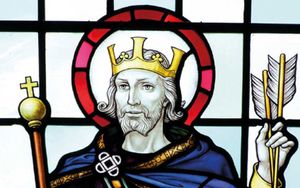Saint Edmund
 | |
| Died | 20 November 869 |
England's original patron saint | |
Edmund the Martyr (also known as Saint Edmund or Edmund of East Anglia) was King of East Anglia from about 855 until his death on 20 November 869.
Almost nothing is known about St Edmund. He is thought to have been of East Anglian origin and was first mentioned in an annal of the Anglo-Saxon Chronicle, written some years after his death. The kingdom of East Anglia was devastated by the Vikings, who destroyed any contemporary evidence of his reign. Later writers produced fictitious accounts of his life, asserting that he was born in 841, the son of Æthelweard, an obscure East Anglian king, whom it was said Edmund succeeded when he was fourteen (or alternatively that he was the youngest son of a Germanic king named Alcmund). Later versions of Edmund's life relate that he was crowned on 25 December 855 at Burna (probably Bures St. Mary in Suffolk), which at that time functioned as the royal capital,[1] and that he became a model king.
In 869, the Great Heathen Army advanced on East Anglia and killed St Edmund. He may have been slain by the Danes in battle, but by tradition he met his death at an unidentified place known as Haegelisdun, after he refused the Danes' demand that he renounce Christ: the Danes beat him, shot him with arrows and then beheaded him, on the orders of Ivar the Boneless and his brother Ubba. According to one legend, his head was then thrown into the forest, but was found safe by searchers after following the cries of an ethereal wolf that was calling, in Latin, "Hic, Hic, Hic" – "Here, Here, Here".
A coinage commemorating St Edmund was minted from around the time East Anglia was absorbed by the kingdom of Wessex and a popular cult emerged. In about 986, Abbo of Fleury wrote of his life and martyrdom. The saint's remains were temporarily moved from Bury St Edmunds to London for safekeeping in 1010. His shrine at Bury was visited by many kings, including Canute, who was responsible for rebuilding the abbey: the stone church was rebuilt again in 1095. During the Middle Ages, when St Edmund was regarded as the patron saint of England, Bury and its magnificent abbey grew wealthy, but during the Dissolution of the Monasteries, his shrine was destroyed. Medieval manuscripts and works of art relating to St Edmund include Abbo's Passio Sancti Eadmundi, John Lydgate's 14th-century Life, the Wilton Diptych and a number of church wall paintings.[2]
Related Document
| Title | Type | Publication date | Author(s) | Description |
|---|---|---|---|---|
| Document:St Edmund – England's original patron saint | Article | 23 April 2019 | William Cook | St George’s Day is on 23rd April. Every time his feast day comes around, I wonder why England puts up with having such a rubbish patron saint? |
References
- ↑ Saint Edmund King and Martyr. 1970. p. 19. ISBN 9780900963186.
- ↑ Document:St Edmund – England's original patron saint
Wikipedia is not affiliated with Wikispooks. Original page source here